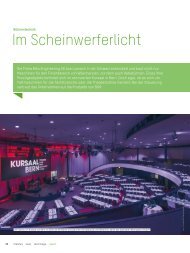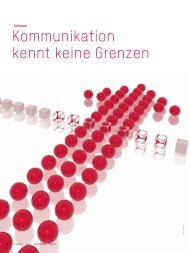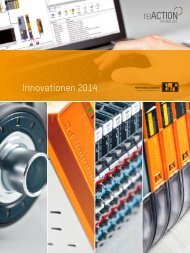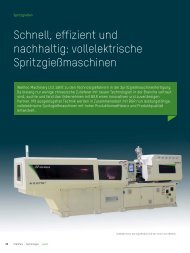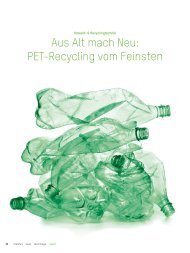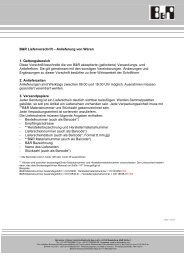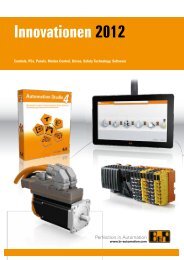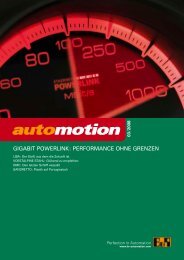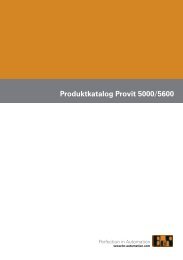automotion automotion automotion automotion - B&R Industrie ...
automotion automotion automotion automotion - B&R Industrie ...
automotion automotion automotion automotion - B&R Industrie ...
You also want an ePaper? Increase the reach of your titles
YUMPU automatically turns print PDFs into web optimized ePapers that Google loves.
only solved this problem and took<br />
a big step forward; we also eliminated<br />
any conceivable performance<br />
bottlenecks."<br />
the FeRAg expert is referring in part<br />
to the continuously increasing turnout<br />
of the rotary printing machines<br />
prevalent in the printing industry,<br />
which the subsequent print finishing<br />
machines must then keep up with.<br />
Rotary printing machines are used<br />
primarily to produce newspapers,<br />
magazines, catalogs, flyers, books<br />
and other printed materials in middle<br />
and high quantities.<br />
more complex products, such as<br />
phonebooks, are composed of numerous<br />
different signatures. these<br />
are usually produced one after another<br />
on a single rotary printer. Finished<br />
signatures must therefore be<br />
stored intermediately.<br />
print shops that specialize in job<br />
printing, such as advertising brochures<br />
and other occasional printed<br />
materials, also often need to store<br />
their products temporarily. this is<br />
the case, for example, for advertising<br />
materials that accompany newspapers<br />
and are printed in advance.<br />
In these and similar cases, it has<br />
proven effective to store the printed<br />
materials in the form of "logs". this<br />
is where the multiLog from FeRAg<br />
comes into play. It receives the<br />
folded and creased signatures from<br />
the rotary printer and stacks them in<br />
logs, which can contain thousands<br />
of signatures. One unique feature<br />
of the log former from FeRAg is the<br />
large, covered format area (190 x 135<br />
mm up to 500 x 320 mm); another is<br />
The new MultiLog can handle up to 120,000 copies per hour.<br />
the loose structure of the logs. this<br />
prevents loops from forming and<br />
the ink from smearing, which would<br />
reduce the quality of the end product,<br />
or even result in a misprint. the<br />
gentler handling of the paper also allows<br />
thinner print items with as few<br />
as 8 pages to be processed.<br />
POWERLINK replaces CAN<br />
the challenge is not only that paper<br />
can vary greatly in composition and<br />
thickness and that signatures can<br />
contain different amounts of air,<br />
which makes handling more difficult,<br />
but also that modern high-performance<br />
rotary printers with which<br />
the multiLog is used have such a<br />
high processing speed.<br />
the rotary printers used in job printing<br />
have typically printed between<br />
60,000 and 70,000 copies per hour.<br />
"Recently, however, we had the first<br />
case where the printer was designed<br />
for 120,000 copies per hour," reports<br />
the FeRAg electrical engineering<br />
department manager.<br />
"the processing speed<br />
With POWERLINK communication,<br />
the MultiLog is capable<br />
of achieving even the<br />
highest processing speeds.<br />
Application<br />
this requires would have brought<br />
our previous architecture, with one<br />
CAN bus driving the machine's six<br />
servo axes and a second to connect<br />
the I/Os and frequency inverter, to<br />
its limits." When planning the modernization,<br />
FeRAg therefore was<br />
looking for an alternative to the CAN<br />
bus that had already established<br />
itself, yet had sufficient reserves to<br />
handle existing and future developments.<br />
"the decision came down<br />
to pOWeRLINK and etherCAt," explains<br />
the FeRAg manager. A third<br />
product from a well-known automation<br />
manufacturer had been eliminated<br />
from the decision early on<br />
due to technical reasons. multiple<br />
factors contributed to the final decision<br />
in favor of pOWeRLINK, as the<br />
FeRAg manager summarizes: "We<br />
decided for pOWeRLINK, because<br />
of our previous positive experiences<br />
with B&R products. In the end, the<br />
deciding factors were the integrated<br />
and reliable safety technology."<br />
Flexibility through integrated<br />
safety<br />
As a beta user, FeRAg was one of<br />
the first companies to benefit from<br />
the advantages of B&R's integrated<br />
safety technology: "the cabling is<br />
considerably easier, and we saved<br />
space on the mounting rail, compared<br />
to the traditional solution with<br />
contactors and e-stop circuits or a<br />
separate safety controller," praise<br />
the software developers from >><br />
<strong>automotion</strong> 07/2009<br />
35



